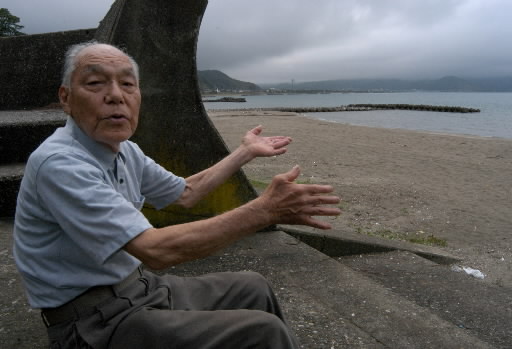Nuclear Reactors Rekindled, Part 1, Article 5
Jul. 1, 2012
Part 1: Through the eyes of A-bomb survivors
Article 5: Concentration of nuclear power plants
by Michiko Tanaka and Hiroshi Ebisu, Staff Writers
Citizens’ anxiety overlooked
On July 1, amid a steady rainfall, protesters reacted to the restart of the No. 3 reactor at the Oi nuclear power plant with chants of opposition. In front of the gate to the nuclear facility, located in Oi, Fukui Prefecture and operated by the Kansai Electric Power Company, members of a citizens’ group formed a barricade with cars and chains, prompting a confrontation with the Fukui Prefectural Riot Police.
Watching a TV program showing the scene, Toshinao Fujiuchi, 90, said, “Despite all the fuss, the reactors will be restarted.” Mr. Fujiuchi is a resident of Takahama-cho, a town down the road from Oi, where the plant is located.
Fukui Prefecture, which is known for its concentration of nuclear power plants, has some 15 reactors along the shores of Wakasa Bay. Mr. Fujiuchi’s house is near the coast, about five kilometers southeast of the Takahama nuclear power plant and about 12 kilometers southwest of the Oi nuclear power plant. The No. 1 reactor at the Takahama plant went online in 1974 and the No. 1 reactor at the Oi plant was started in 1979.
Back then, when a meeting was held to inform local residents about the construction of the Takahama plant, Mr. Fujiuchi expressed opposition to the plan, saying, “We take pride in the sea here, but people won’t visit it anymore.” But with other residents welcoming the power station, stressing how the town would benefit, Mr. Fujiuchi stopped speaking out. The rush to construct nuclear power plants in the region then began.
In the summer of 1945, 67 years ago, Mr. Fujiuchi experienced the atomic bombing while aboard a ship berthed at Ujina Port in Minami Ward, Hiroshima, where he had been conscripted. He witnessed many people groaning in agony at a first-aid station, and eventually dying. Recalling the time, he said, “I’ve lived my life with the thought that I might die at anytime.”
After returning to his hometown in Fukui Prefecture, he worked there for a lumber company and a landscaping firm. For years Mr. Fujiuchi has recognized that both the atomic bomb, which wrought such horror to Hiroshima, and nuclear power plants make use of the same atomic energy, and yet his community has been enticed into embracing the danger.
Though people have gathered to oppose the restart of the Oi nuclear plant, there are no local residents among them. “Our town could have survived without relying on the nuclear plants,” Mr. Fujiuchi said. “But I suppose it’s too late for this sort of thinking.” The No. 4 reactor was restarted on the evening of July 18.
Earlier, on July 9, the No. 3 reactor resumed full operations. The next day, July 10, Mayumi Tokunaga, 73, spoke about restarting the nation’s nuclear power plants. “The plants are being restarted,” she said, her face clouded with concern, “despite the fact that no one has taken any responsibility for the accident here in Fukushima.” Ms. Tokunaga lives alone in the city of Iwaki, Fukushima Prefecture, about 40 kilometers south of the Fukushima No. 1 (Daiichi) nuclear power plant.
Ms. Tokunaga took out a bundle of bank books. Every October, a “nuclear energy benefit” of 4,056 yen is remitted to her account. The amount was even remitted in 2011, after the accident. The money comes from a government subsidy, called the “Grant for Locating Electric Power Plants,” which is paid to municipalities and other entities in the vicinity of nuclear power stations. Troubled by these payments, Ms. Tokunaga said, “The money makes me feel as if I shouldn’t say anything, in spite of the accident.”
As a consequence of the disaster that struck Fukushima in March 2011, even today about 160,000 people from the prefecture are living as evacuees. In Iwaki, where Ms. Tokunaga resides, about 7,800 people, including many of her neighbors, have left the city.
Sharing her empathy, Ms. Tokunaga said, “I can understand the feelings of the people who evacuated. Radiation is invisible, and it’s horrifying.” But she has remained in the city because “I’m used to my life here and I don’t want to leave.”
Ms. Tokunaga was born in Funairi-machi, part of Hiroshima’s Naka Ward. She experienced the atomic bombing at a location near her house, about two kilometers from the hypocenter. Her mother had been mobilized to a work site in the city that day, and was killed in the blast. Her father died on the front lines in the Philippines.
After the war, the orphaned girl was taken in by her maternal grandfather and lived with his family in Iwaki. She has never married, spending her life running a diner.
“The atomic bomb and the nuclear plant have both stolen away my family and my hometown,” she said. Linking her own experience of the bombing with current conditions in Fukushima, Ms. Tokunaga views nuclear weapons and nuclear power plants as the same “nuclear energy.”
This article concludes Part 1 of the series.
(Originally published on July 20, 2012)








